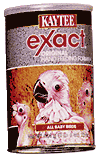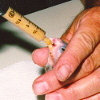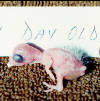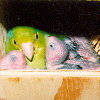Parrotlets: Introduction to their Care & Breeding
| We are no longer breeding Parrotlets. We will continue to provide our web pages on Parrotlet care and breeding, but will no longer be able to answer Parrotlet questions due to limited time. See our Parrotlet Resource page for links to other useful Parrotlet websites, chat groups and organizations. | |||
|---|---|---|---|
|
Please visit our Caique and Brotogeris Parakeet webpages |
|||
|
|
|||||
|
General Info Most people consider Parrotlets to be miniature Amazons. That is because their personality, character and nature is closest to their larger cousins. They are bold, confident, playful, clownish, fearless and determined, all wrapped up in a tiny green bundle of feathers. Also known as "pocket parrots," these small birds are true parrots in every sense of the word. They are easy and inexpensive to maintain due to their small size and are nowhere as destructive as most larger birds. They are incapable of screaming, and can be even kept in a small apartment without fear of complaints from the neighbors. A hand-fed Parrotlet kept singly can make a wonderful pet. I do not recommend keeping two or more together as pets because they are likely to bond to each other and as a result, have no need for human interaction. Parrotlets have a limited talking ability, but with patience and practice, can learn to say several words, short phrases, and many sounds and whistles. back to index Interaction with other Birds Caution must be advised regarding interaction with other birds. Very often a Parrotlet, especially a Pacific, will attack a much larger bird with no regard for their own small size. Particularly when they become mature enough to breed, they can become especially hostile toward other birds. I once had a young female Pacific attack a Rosella more than three times her size which resulted in the loss of a toe to the Rosella. Do not allow your Parrotlet to be unsupervised around other birds. back to index Origin Parrotlets share much of the same regions with large parrots such as Macaws, Amazons, Conures, and Pionus. Their range spreads from the arid tropical zone of western Mexico, along the west coast just below Baja, California to the southernmost parts of Brazil and from the east to west coasts of South America. They inhabit Trinidad and have been introduced to the Netherlands Antilles and the West Indies. In the wild, Parrotlets feed on blossoms, seed heads, fruits and berries. back to index Species Identification Of the many species of Parrotlets available in the US, Pacifics are the most common having been imported in large numbers during the 80s. Second comes the Green Rumped, with the other species having been imported in much smaller quantities. For detailed identification and photos of each species go to the Parrotlet page. back to index Sexing Parrotlets An important quality of Forpus Parrotlets is that they are sexually dimorphic. This means that the sex of the bird can be determined by visual observation which makes pairing birds easy and does not require surgical or genetic sexing. In all but one of the species within the Forpus genus, the males have a varying amount of vivid or deep blue on their rumps. The males of all species have shades of vivid blue on primary and secondary feathers on their wings. The females are similar in appearance but always lack the blue markings on the wings. Even young chicks can be sexed by their coloration, another bonus when deciding which offspring to hold back for future breeders. The only species in which the females have blue on the wing are the Yellow Face, and even then, the blue is of a much paler shade. back to index Diet A major part of the diet Shady Pines feeds it's birds is fresh food. The following mixture is fed daily, 365 days per year: frozen mixed vegetables consisting of corn, peas, carrots, lima beans, and green beans. These are not cooked, but rather are placed in a colander under running hot water to defrost. Fresh broccoli, carrots, and zucchini or yellow  squash are coarsely chopped in a food processor and added to the thawed mixed vegetables. This mixture is then added to an equal amount of sprouted beans. Dried lentils, mung beans and Chinese red peas are soaked overnight then allowed to sprout the following day. They are carefully rinsed and allowed to slowly drain several times during the day while sprouting. Extreme caution must be used to not damage the beans which can cause them to spoil. Sprouted beans are refrigerated to prevent spoilage and are used within 24 hours. The fresh food portion of the diet is often supplemented with other vegetables and fruits in season such as: fresh corn on the cob, baked sweet potato, greens, apples, oranges, grapes, peaches, pears, melon, berries, cherries, and kiwi. squash are coarsely chopped in a food processor and added to the thawed mixed vegetables. This mixture is then added to an equal amount of sprouted beans. Dried lentils, mung beans and Chinese red peas are soaked overnight then allowed to sprout the following day. They are carefully rinsed and allowed to slowly drain several times during the day while sprouting. Extreme caution must be used to not damage the beans which can cause them to spoil. Sprouted beans are refrigerated to prevent spoilage and are used within 24 hours. The fresh food portion of the diet is often supplemented with other vegetables and fruits in season such as: fresh corn on the cob, baked sweet potato, greens, apples, oranges, grapes, peaches, pears, melon, berries, cherries, and kiwi.Two different high quality large hookbill mixtures are also fed; one safflower based (Sunshine's Safflower Gold ™) and the other sunflower based (Nederlands ™ Parrot D'lite Vita Seed), not the parakeet seed their small size would suggest. ZuPreem ™ Cockatiel-size pellets complete the daily diet. The sunflower mixture is added sparingly to the total mixture. In addition, spray millet, whole grain breads and birdie corn bread are offered regularly as a treat. Pairs feeding chicks additionally get CéDé ™ Egg Food which has been slightly moistened; this is replenished several times daily. Pairs with chicks also get an additional serving of veggies in the afternoon so they have ample soft food to feed their family. All cages contain cuttlebone which is replaced frequently. Egg-laying hens that are not consuming cuttlebone receive supplemental calcium on their soft food to prevent egg laying problems. back to index Breeding I would not recommend a wild caught Parrotlet for anything but breeding. Prices for Parrotlets (normal color, not mutations) range anywhere from $100.00 to $300.00 each, depending on the species and area of the country. This makes them affordable for the beginner who does not want to make a large investment. Parrotlets are easy to breed if a few simple guidelines are followed. Two birds set up for breeding must be a true pair of any given species. I have seen many hybrids produced by people not knowing how to differentiate between the species. Only true pairs should be allowed to reproduce if the Parrotlet species are to thrive. back to index Breeding Season There is no defined breeding season for Parrotlets kept indoors. I have had pairs produce in every month of the year. Although there are two windows in my current indoor birdroom, I use full spectrum lighting at the rear of each cage unit. The lights come on at 8am and go off at 11pm. Although the room is air-conditioned, in the summer months the daytime temperature never falls below 80 . In warm climates where the birds are housed outdoors year round they will generally breed in all but the hottest months. back to index Caging Most breeders have the best success with caging anywhere from 18" square up to 48" long and anything in between. We are currently using double breeder units with each side measuring 18"x18"x20" with about 20 inches between units. If cages are placed too close together, the birds may spend all their time arguing and fighting with any neighbor they can see. A visual barrier must be placed between each cage to avoid potential problems. A Parrotlet will kill its mate to keep it away from, or from flirting with others. Plans are being drawn for our new aviary which will allow for larger breeding units as well as large flights for juveniles. back to index Pairing The disposition of the Parrotlet carries over to breeding practices. Protect them from territorial fights by not putting adult pairs together or in close proximity. If in a double breeder cage, the divider must be solid, not wire. Although some have tried colony-breeding in large cages or flights, they can become very aggressive during breeding and have been known to kill even their own mates or chicks. I prefer the safety of one pair to a cage and a visual barrier between cages. Some breeders believe that Parrotlets tend to bond for life. On quite a few occasions, however, I have split up and re-paired unproductive or problem pairs with the result being chicks produced with their new mates. You must be careful and handle the situation very cautiously. When setting up a new pair, the hen is place in the breeding cage several days before the male so that she may become familiar with her new surroundings. Once the male is placed in the cage, watch them from a distance to make sure normal arguing and bickering does not escalate to serious injury. Be ready to step in immediately if you feel either bird is in danger. back to index Nestboxes Parrotlets are not nest builders, they will generally accept just about anything provided for them. We use a large budgie nestbox which measures 6" x 7" and are 8" high. Approximately two inches of finely cut pine shavings are placed in the box. Some hens will throw out most of the nesting material, when this happens, I just replenish the material to prevent complications when eggs are laid and chicks begin hatching. Use of the nestboxes will vary from pair to pair. Some pairs will only use their nestboxes at night for sleeping. Others, particularly Green Rumps who tend to be shy, will use them to hide in. Still other pairs will use them only when breeding, never venturing near the box at any other time. Often the male is the first to investigate and enter the nestbox. Once inside he may call to his mate to join him. In other pairs the female will suddenly disappear into the box and hopefully the first egg will appear soon after. back to index Egg Laying A Parrotlet hen will appear swollen in the vent area before eggs are laid. Another indication of impending egg laying is extremely large droppings. The average clutch will usually be four to seven eggs, although I've heard of up to 10 eggs being laid. The eggs will be laid every other day until the clutch is completed. The hen will not always sit tight until the second or third egg is laid. It's not unusual to see several clutches of clear eggs before fertile eggs are produced. A pair may go through several cycles before actually producing chicks. back to index Broken/Missing Eggs Some inexperienced young pairs may destroy their eggs or chicks. If a squabble has taken place in the nestbox and an egg has broken, the hen may eat the broken egg in an attempt to keep the nestbox clean. If the eggs are being deliberately destroyed, replace the newly laid egg with a plastic egg. Once the birds realize the eggs can't be destroyed, the problem is usually solved. It is not uncommon for this to occur to young, inexperienced pairs. Often the problem will resolve itself and the next clutch will go smoothly. If a pair continues to break their eggs, try to detect which bird is causing the problem. At this point you have no choice but to remove the guilty bird from your breeding program and replace it with a new bird. I have never known of a confirmed egg eater being reformed. back to index Incubation Some hens will sit tight after laying the first egg. In a large clutch this can cause a vast age difference between the oldest and youngest chicks. The incubation period for most Parrotlets is 18 to 19 days with the Mexican taking 21 to 22 days. The hen will spend all of her time in the nestbox coming out only to defecate. The male will feed her either in the nest box or at the entrance hole. Sometimes a male will even help incubate the eggs, although it is uncommon. If several eggs have been laid before the hen begins incubating, it is possible for several chicks to be hatched on the same day. back to index Multiple Clutches Although most pairs will rest between clutches, a very determined pair will continue to lay clutch after clutch. It is these pairs that must have their nestboxes removed for a forced "vacation." A very determined pair will even attempt to nest in a food dish or on the wire grate of the cage. When this happens, the pair is moved to a different cage with new neighbors and an entirely different view. This generally results in breaking the breeding cycle. back to index Formula  There are many fine commercial handfeeding formulas available today. I have used Kaytee Exact ™ formula exclusively since 1990 with excellent results. The formula is used without any additives with the exception of Baby Papaya Desert or fresh pureed Papaya which comprises no more than 15% of the total formula. This is added for both palatability as well as for the natural digestive enzymes it contains. The formula is prepared according to the manufacturers directions and fed at between 105 and 108 .
There are many fine commercial handfeeding formulas available today. I have used Kaytee Exact ™ formula exclusively since 1990 with excellent results. The formula is used without any additives with the exception of Baby Papaya Desert or fresh pureed Papaya which comprises no more than 15% of the total formula. This is added for both palatability as well as for the natural digestive enzymes it contains. The formula is prepared according to the manufacturers directions and fed at between 105 and 108 .back to index Handfeeding Most chicks are removed from the nestbox for handfeeding at 10 days of age; younger if the clutch is large. I never allow more than four chicks in the nest, the oldest chick is removed on the day chick #5 hatches and this is repeated as each new chick hatches.  Having less chicks in the nest at one time puts less strain on the parents and gives the small, newly hatched chicks a better chance at survival. Chicks removed at eight to ten days old are place in a brooder at 92° where they remain for approximately five to seven days. During this period they require five feedings per day. The amount fed at each feeding can vary from chick to chick. They are fed until the crop is well rounded, but never tight which can lead to accidental aspiration. At 15 days of age they are moved to the next brooder which is maintained at 86°. By this time more formula is given at each feeding so the time between feedings is increased and one feeding is eliminated. They remain at this temperature and schedule until their pin feathers have started to open at about 3 - 3½ weeks. They are then moved to a large plastic aquarium where various weaning foods are introduced. Having less chicks in the nest at one time puts less strain on the parents and gives the small, newly hatched chicks a better chance at survival. Chicks removed at eight to ten days old are place in a brooder at 92° where they remain for approximately five to seven days. During this period they require five feedings per day. The amount fed at each feeding can vary from chick to chick. They are fed until the crop is well rounded, but never tight which can lead to accidental aspiration. At 15 days of age they are moved to the next brooder which is maintained at 86°. By this time more formula is given at each feeding so the time between feedings is increased and one feeding is eliminated. They remain at this temperature and schedule until their pin feathers have started to open at about 3 - 3½ weeks. They are then moved to a large plastic aquarium where various weaning foods are introduced.back to index Weaning Once in the weaning container, many different foods are offered which include the same vegetable/sprout mixture given to the adults, cockatiel size pellets, dry egg food, Petamine ™, crumbled birdie cornbread and a tiny seed/treat mixture containing dried fruits and vegetables (Sunshine's ™ Small Bird Treat). As the youngsters begin to sample and eat the various weaning foods, the amount of formula fed at each feeding is decreased with the exception of the last feeding at night which is a full feeding. Formula is continued to be offered four times daily until they are fully weaned. Often at feeding time their crops are already full of weaning foods and formula is refused. They are moved to a weaning cage when fully feathered and attempting to fly. Parrotlets tend to wean themselves practically overnight, especially if they are being raised in a group. A single chick will often want to be hand-fed longer. Weaning is usually completed by six weeks of age. Larger hookbill seed mix is not given until they are fully weaned and have developed an appetite for all of the other types of food. back to index Banding Your Chicks If you plan on banding your chicks you should not return them to the nest unless the parents also wear a band. A parent that does not wear a band will usually not allow a band on it's chick. Many chicks are injured or killed at this time by parents trying to remove the unfamiliar object from the chick's leg. English Parakeet size bands (5/32" or 3.90mm) purchased from L&M Bands are now being used for all species of Parrotlets and are put on at ten days of age when removed for handfeeding. In the past we have used lovebird size bands for Pacifics, Blue Wings and Mexicans, but feel the English Parakeet size is a better fit. For more detailed information on banding, go to Banding: How and Why. back to index Raising Day One Chicks  In emergencies, chicks have been raised from day one, but only when absolutely necessary. A newly hatched Parrotlet being hand-reared must be fed about every 30-45 minutes the first day since such a small amount is taken at each feeding. Formula is made using a commercial electrolyte solution such as Infalyte ™ (a rice-based ) or Pedialyte, in place of water for the first four to five days. The time between feedings is increased as is the amount fed each time so that by 10 days old the chick is being fed every four hours, the same as a 10 day old chick being pulled from the nest.
In emergencies, chicks have been raised from day one, but only when absolutely necessary. A newly hatched Parrotlet being hand-reared must be fed about every 30-45 minutes the first day since such a small amount is taken at each feeding. Formula is made using a commercial electrolyte solution such as Infalyte ™ (a rice-based ) or Pedialyte, in place of water for the first four to five days. The time between feedings is increased as is the amount fed each time so that by 10 days old the chick is being fed every four hours, the same as a 10 day old chick being pulled from the nest.back to index Sexing Baby Parrotlets A Parrotlet chick is almost fully feathered by 3½ weeks of age. Sex of a youngster can be determined with certainty by this time. With practice and good light, sex of a chick can often be known as young as 15 days. As the primary pin feather quills emerge, the blue color is obvious in all males, regardless of the species. In some species of parrotlet, the blue on the rump of the male may be sparse or not seen at all until the juvenile molt which usually occurs between 3½ to five months of age. In the Pacific Parrotlet however, the deep cobalt blue rump in visible in the juvenile plumage although it may intensify after the molt. back to index Parent Raised Chicks  On a few occasions I have left the two youngest chicks in the nest to be raised by the parents. They generally fledge at about four weeks of age although they will still be fed by their parents and continue to sleep in the nestbox. A close watch must be kept on the behavior of the parents toward the chicks. The male parent may be aggressive toward all male chicks. If the hen starts to lay another clutch of eggs, she also may be hostile toward her offspring in an effort to evict them from the nestbox.
On a few occasions I have left the two youngest chicks in the nest to be raised by the parents. They generally fledge at about four weeks of age although they will still be fed by their parents and continue to sleep in the nestbox. A close watch must be kept on the behavior of the parents toward the chicks. The male parent may be aggressive toward all male chicks. If the hen starts to lay another clutch of eggs, she also may be hostile toward her offspring in an effort to evict them from the nestbox.back to index Mutation Parrotlets In recent years many beautiful color mutations of Pacifics parrotlets have been developed. These include American yellow, European yellow (pastel), blue, fallow and lutino. For detailed identification and photos go to the Mutation Parrotlet page. back to index Non-Forpus Parrotlets Nannopsittaca - 2 species, no sexual dimorphism
Touit - poorly-known genus, 7 species identified, sexual dimorphism in most species.
|
|||||
Product Links
|
Sunshine Bird Supplies 3198 NW 125th Street Miami, Florida 33167 (800) 878-2666 fax (305) 591-9567 |
Sunshine's Safflower Gold (small) Nederlands Parrot D'lite Vita Seed Small Bird Treat w/Exotic Fruits & Veggies Sunshine Supreme Spray Millet CéDé Egg Food |
|
ZuPreem PO Box 2094 Mission, KS 66202 (800) 345-4767 |
Fruit Blend Cockatiel Pellets |
|
Kaytee Products Inc. P.O. Box 230 292 E. Grand Street Chilton, Wisconsin 53014 (800) 669-9580 fax (414) 849-2415 |
Exact Handfeeding Formula |
|
L & M Bird Leg Bands P.O. Box 2943 San Bernardino, CA 92406 (909) 882-4649 fax (909) 882-5231 |
English Parakeet Bands (5/32" or 3.90mm) |
|
Kellog |
Petamine |
|
back to index |
Copyright © 1998-2008 Shady Pines Aviary - No part of this page may be reproduced without the express permission of the author.
